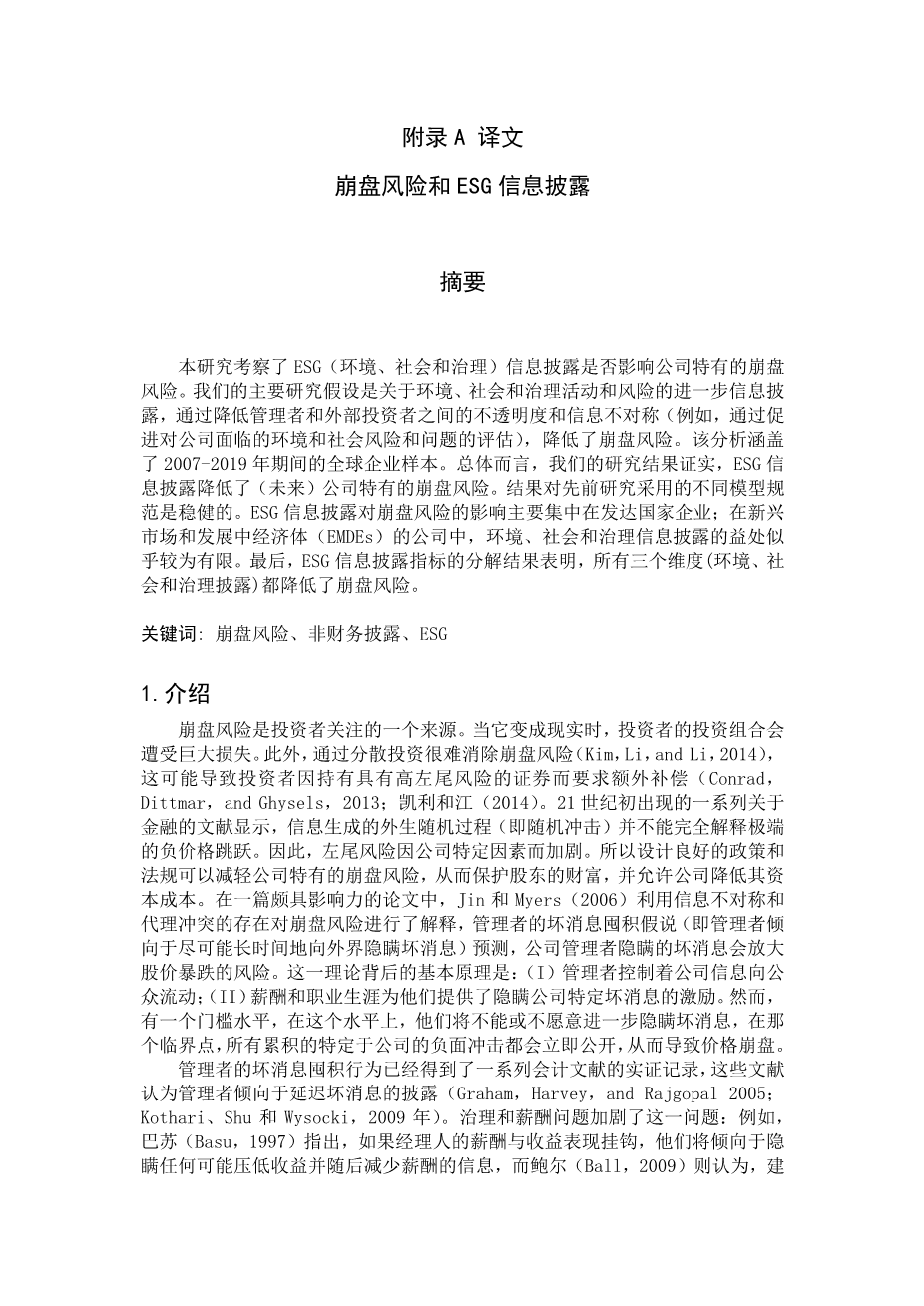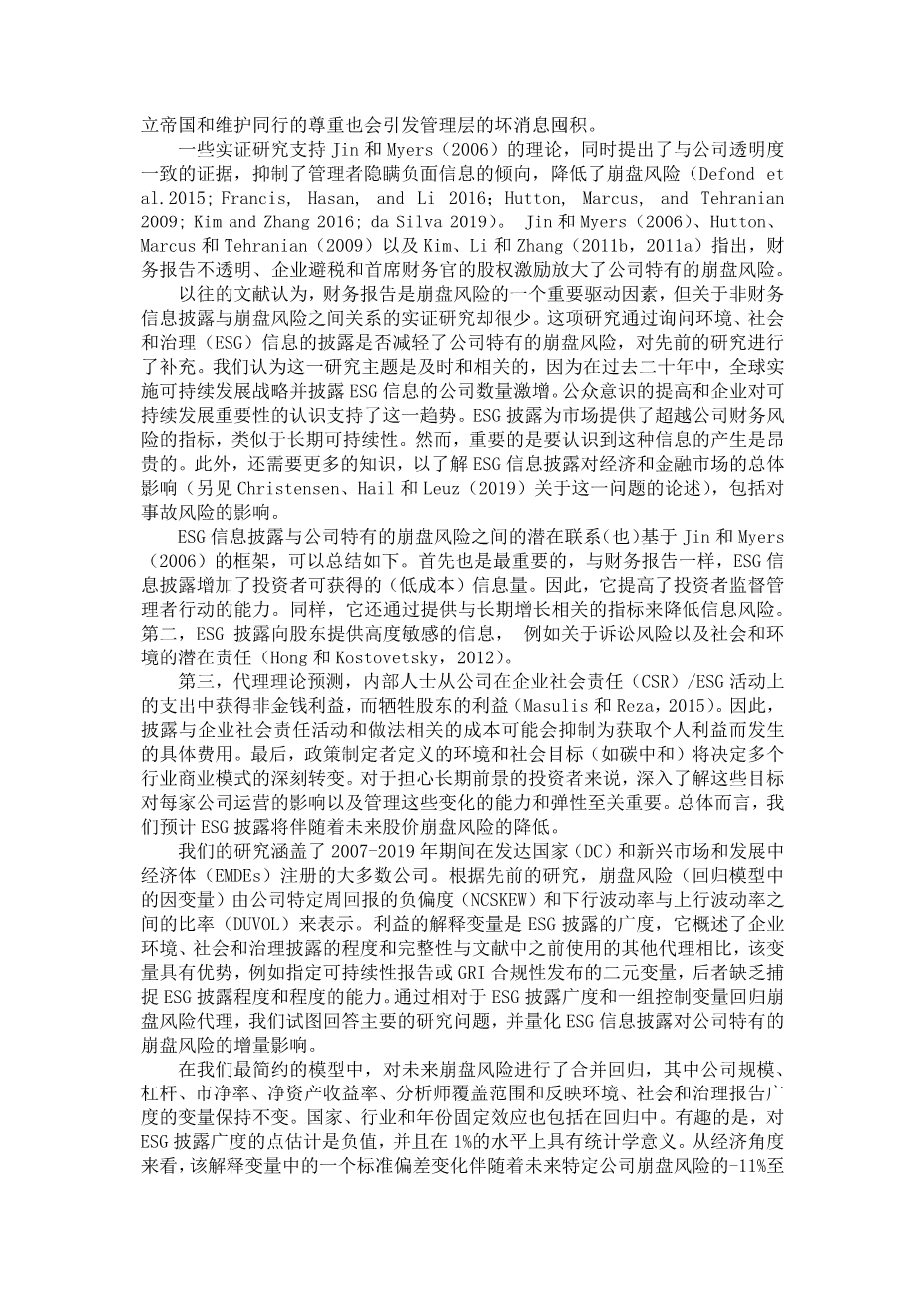崩盘风险和ESG信息披露外文翻译资料
2023-04-13 10:44:35
附录B 外文原文
Crash Risk and ESG Disclosure
Abstract
This study examines whether ESG (environmental, social and governance) disclosure influences firm-specific crash risk. Our main research hypothesis postulates that further information disclosure about ESG activities and risks mitigates crash risk by virtue of lower opacity and information asymmetry between managers and outside investors (e.g., by facilitating the assessment of environmental and social risks and concerns faced by the firm). The analysis covers a global sample of firms and the period spanning 2007–2019. Overall, our findings confirm that ESG disclosure attenuates (future) firm-specific crash risk. The results are robust to different model specifications employed by previous research. The impact of ESG disclosure on crash risk is concentrated on firms from developed countries; benefits from ESG disclosure appear to be more limited in firms located in emerging markets and developing economies (EMDEs). Finally, the results from the decomposition of the ESG disclosure indicator suggest that all three dimensions (environmental, social and governance disclosure) weigh crash risk downwards.
Keywords Crash risk; Non-financial disclosure; ESG
1. Introduction
Crash risk is a source of concern for investors. When it materializes, investors suffer substantial losses on their portfolios. Moreover, crash risk is hardly eliminated via diversification (Kim, Li, and Li 2014), which could lead investors to require additional compensation for holding securities with high left-tail risk (Conrad, Dittmar, and Ghysels 2013; Kelly and Jiang 2014). A relevant stream of the financial literature that emerged in the early 2000s claims that extreme negative price jumps are not entirely explained by the exogenous stochastic process of information generation (i.e., random shocks). Accordingly, left-tail risk is exacerbated by firm-specific factors. Hence, well-designed policies and regulations could allay firm-specific crash risk, thereby protecting shareholdersrsquo; wealth and allowing firms to decrease the cost of their capital.
In an influential paper, Jin and Myers (2006) offer an explanation for crash risk which draws on the existence of information asymmetry and agency conflicts. The managerial bad news hoarding hypothesis (i.e., the tendency of managers to hide bad news as long as possible from outsiders) predicts that bad news concealed by firm managers amplifies the risk of stock price crash. The rationale behind this theory is that (i) managers control the flow of the firmrsquo;s information to the public and (ii) compensation and career concerns provide them with incentives to hide firm-specific bad news. However, there is a threshold level at which they will be unable or unwilling to conceal bad news further. At that tipping point, all accumulated negative firm-specific shocks become public at once, thereby generating a price crash.
The managerial bad news hoarding behavior has been empirically documented by a stream of the accounting literature arguing that managers prefer to delay the disclosure of bad news (Graham, Harvey, and Rajgopal 2005; Kothari, Shu, and Wysocki 2009). This issue is exacerbated by governance and compensation issues: for instance, Basu (1997) notes that if managersrsquo; compensation is tied to earnings performance, they will tend to withhold any information that could depress earnings and, subsequently, reduce compensation, whereas Ball (2009) suggests that empire building and maintaining the esteem of onersquo;s peers also trigger managerial bad news hoarding.
Several empirical studies support Jin and Myers (2006) theory while presenting evidence consistent with corporate transparency curbing managersrsquo; tendencies to conceal negative information and reducing crash risk (DeFond et al. 2015; Francis, Hasan, and Li 2016; Hutton, Marcus, and Tehranian 2009; Kim and Zhang 2016; da Silva 2019). Jin and Myers (2006), Hutton, Marcus, and Tehranian (2009) and Kim, Li, and Zhang (2011b, 2011a) show that financial reporting opaqueness, corporate tax avoidance, and CFOrsquo;s equity incentives amplify firm-specific crash risk.
Financial reporting was established as a prominent driver of crash risk by prior literature, but empirical research on the association between non-financial disclosure and crash risk is scant. This study adds to previous research by asking whether the disclosure of environmental, social and governance (ESG) information alleviates firm-specific crash risk. We consider this topic of research timely and relevant because the number of firms implementing sustainability strategies and disclosing their ESG information surged globally over the last two decades. Growing public awareness and corporate acknowledgment of the importance of sustainable development supported this trend. ESG disclosure provides the market with metrics that go beyond a firmrsquo;s financial risks and which are akin to long-term sustainability. However, it is important to realize that the production of such information is costly. Also, more knowledge is desirable to understand the overall impact on the economy and financial markets of ESG disclosure (see also Christensen, Hail, and Leuz (2019) on this issue), including effects on crash risk.
The potential links between ESG disclosure and firm-specific crash risk are (also) grounded in Jin and Myers (2006) framework and can be summarized as follows. First and foremost, like financial reporting, ESG disclosure increases the amount of (low-cost) information available to investors. As such, it enhances the investorsrsquo; capacity to monitor managersrsquo; actions. Similarly, it also reduces information risk by furnishing metrics that are attached to long-term growth. Second, ESG disclosure delive
剩余内容已隐藏,支付完成后下载完整资料


英语译文共 10 页,剩余内容已隐藏,支付完成后下载完整资料
资料编号:[589542],资料为PDF文档或Word文档,PDF文档可免费转换为Word




